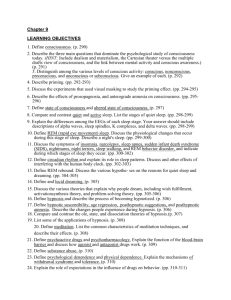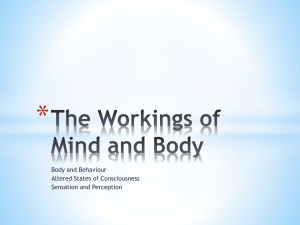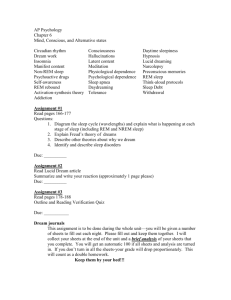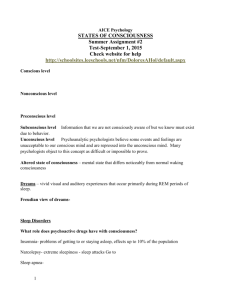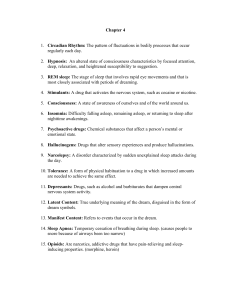Consciousness and its Variations
advertisement
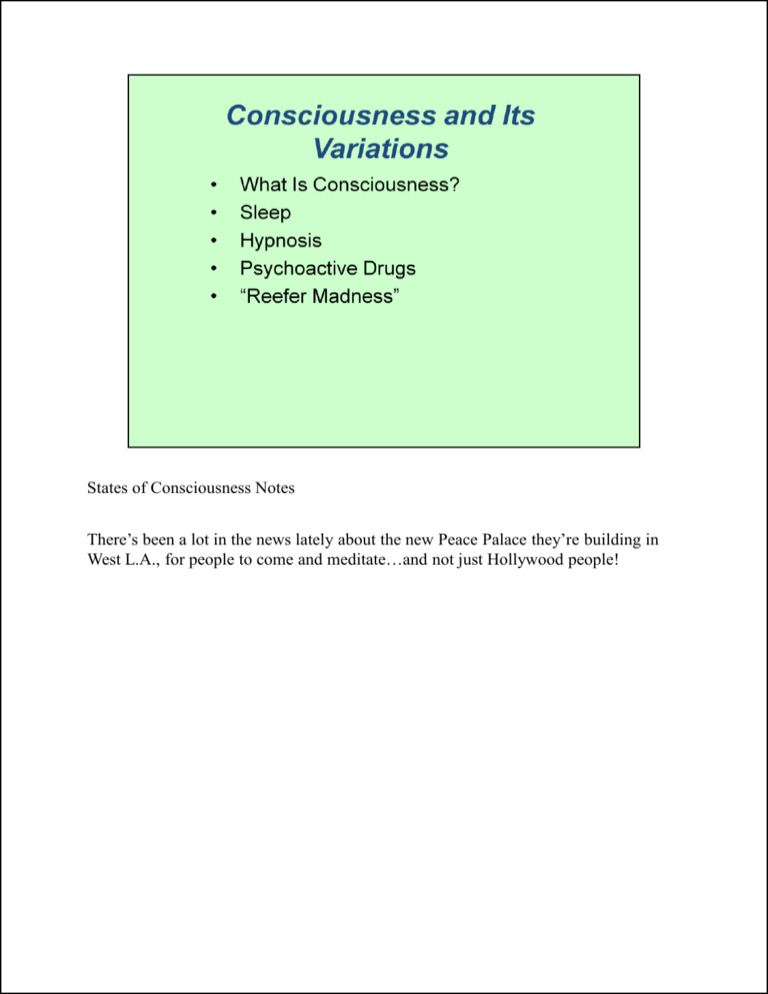
States of Consciousness Notes There’s been a lot in the news lately about the new Peace Palace they’re building in West L.A., for people to come and meditate…and not just Hollywood people! Consciousness is awareness. This awareness can be altered by sleep, hypnosis, or drugs. Consciousness includes everything of which we are aware at any given time, our thoughts, feelings, mental processes, and events outside ourselves. Various states of consciousness studied by psychologists include ordinary waking consciousness, daydreaming, sleep, and altered states brought about through meditation, hypnosis, or the use of psychoactive drugs. You may have also heard the terms “unconscious” and “subconscious”. Some people use them interchangeably. I tend to use “unconscious” to mean “not aware” (or even asleep), and “subconscious” to mean “below the conscious awareness” (thoughts and feelings that are just out of reach). A little pronunciation for you… Conscious = “con-shuss” Conscience = “con-shunce” – this is the little voice in your head that tells you that you should or shouldn’t do something (As Jiminy Cricket said, “Let your conscience be your guide.”). We’ll learn more about this in a few weeks. During NREM sleep, heart rate and respiration are slow and regular, blood pressure and brain activity are at a 24-hour low point, and there is little body movement and no rapid eye movements. There are four level of NREM sleep. •In a typical night, a person sleeps in sleep cycles, each lasting about 90 minutes. The first sleep cycle contains Stages 1, 2, 3, and 4 and REM sleep; the second contains Stages 2, 3, and 4 and REM sleep. In the remaining sleep cycles, the sleeper alternates mainly between Stage 2 and REM sleep, with each sleep cycle having progressively longer REM periods. Stage 1 - A transition period of drowsiness between waking and sleeping. Stage 2 – Somewhat more deeply asleep. Stage 3 – The beginning of slow wave sleep. Stage 4 – Delta waves reach nearly 100%. During REM sleep, the large muscles of the body are paralyzed, respiration and heart rate are fast and irregular, brain activity increases, and rapid eye movements and vivid dreams occur. REM sleep constitutes 20-25% of adult sleep. During REM sleep there is intense brain activity and most dreaming occurs in REM sleep. REM dreams have a story-like quality and are more vivid, visual, and emotional than the more thoughtlike NREM dreams. REM sleep appears to aid in learning and memory. Following REM deprivation, people experience a REM rebound—an increase in the percentage of REM sleep. Hypnosis is a procedure through which a hypnotist uses the power of suggestion to induce changes in thoughts, feelings, sensations, perceptions, or behavior of a subject. It has been used most successfully for the control of pain. The three main theories proposed to explain hypnosis are the sociocognitive theory, the neodissociation theory, and the theory of dissociated control. •Sociocognitive theory -- the behavior of a hypnotized person is a function of that person’s expectations about how subjects behave under hypnosis. (A self-fulfilling prophecy – you believe that you will make a fool of yourself under hypnosis, so you do!) •Neodissociation theory -- hypnosis induces a split, or dissociation, between two aspects of the control of consciousness. (You’re aware of doing things under hypnosis, but you can’t control it.) •Dissociated control theory -- hypnosis weakens the control of the executive function over other parts of consciousness. (You’re not aware of doing things under hypnosis, and you can’t control it.) Some people seem to be highly suggestible, others aren’t. •Meditation is used by some to promote relaxation and reduce arousal, and by others to expand consciousness or attain a higher spiritual level. Meditation is a type of selfhypnosis. Recent studies show that meditation does reduce brain wave activity and stress. See the activity in this lesson to give it a try! Psychoactive drugs affect brain function. You might not think of all of them as drugs, but they’re all addictive. All addictive drugs increase the availability of dopamine in the nucleus accumbens causing pleasurable sensations that contribute to drug abuse. Individual differences in physiological responses to drugs also play a role. Personality and social variables also contribute to abuse.are needed to get the same effect. Withdrawal symptoms appear when the drug is discontinued and disappear when the drug is taken again. Psychological drug dependence involves an intense craving for the drug. Stimulants increase brain activity, suppress appetite, and make a person feel more awake, alert, and energetic. •Caffeine – my drug of choice! – the elixir of life! Mmmm…coffee. •Nicotine, the stimulant in cigarettes, causes a “buzz” in first-time users which makes teenagers want more. As they become addicted to the nicotine, the “buzz” isn’t as strong, but they continue to smoke because the feel the need of the addiction. •Use of amphetamines (or methamphetamines) energizes, increases arousal, and suppresses the appetite, but continued use results in exhaustion, depression, and agitation. Also known as Speed, Meth, or Crystal Meth. •Cocaine energizes, causes a feeling of euphoria, and is highly addictive. Heavy use can cause heart damage, seizures, and even heart attacks. Depressants decrease activity in the central nervous system, slow down body functions, and reduce sensitivity to outside stimulation. Depressants include alcohol, barbiturates, and tranquilizers. •Narcotics, which include opium, codeine, morphine, and heroin, have painrelieving and calming effects. Hallucinogens, including marijuana, LSD, and MDMA (Ecstasy or X), can alter perception and mood and cause hallucinations. •There is some evidence that heavy marijuana use can cause memory problems, respiratory damage, loss of motivation, impotence, lowered testosterone level and sperm count, and irregular menstrual cycles. •LSD (or acid) causes major hallucinations, and remains in the body chemically for years, causing flashbacks. •Ecstasy was first used as a prescription drug by psychiatrists (!) to help people make leaps in honesty with themselves and others. Unfortunately, the dosages and the abuse went beyond the psychiatrists’ offices. X causes huge spikes in body temperature (which is why you see people drinking a ton of water in clubs), and teeth grinding (which is why you see adults with pacifiers in their mouths – looks pretty silly, if you ask me!). This now-funny classic film from 1938 shows the horror of marijuana use. Women cry for it! Men die for it! The film was intended to teach parents to watch for the warning signs of drug use. Did this actually work? Back then, possibly so. No, I’m not advocating for marijuana use, but the behavior in the film is so over-thetop it’s hard to take its message seriously.

